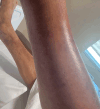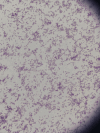Vibrio cholerae Skin and Soft Tissue Infection Complicated by Sepsis in an Immunocompromised Patient: A Rare Case Report
- PMID: 39776773
- PMCID: PMC11705491
- DOI: 10.1002/ccr3.70086
Vibrio cholerae Skin and Soft Tissue Infection Complicated by Sepsis in an Immunocompromised Patient: A Rare Case Report
Abstract
Physicians should consider non-O1, non-O139 Vibrio cholerae (NOVC) in the differential diagnosis of cellulitis complicated by sepsis, especially in immunocompromised patients when potential exposure exists. Due to the pathogen's potential for severe infections and rising incidence from environmental changes, we emphasize the need for increased awareness and appropriate treatment guidelines.
Keywords: Vibrio cholerae; bacteremia; cellulitis; sepsis.
© 2025 The Author(s). Clinical Case Reports published by John Wiley & Sons Ltd.
Conflict of interest statement
The authors declare no conflicts of interest.
Figures




Similar articles
-
Non-O1 and non-O139 Vibrio cholerae Septicemia and Cellulitis: a Case Report.New Microbiol. 2024 Jul;47(2):190-193. New Microbiol. 2024. PMID: 39023531
-
Non-O1, non-O139 Vibrio cholerae bacteremic skin and soft tissue infections.Infect Dis (Lond). 2016;48(3):171-6. doi: 10.3109/23744235.2015.1104720. Epub 2015 Oct 26. Infect Dis (Lond). 2016. PMID: 26503346 Review.
-
Think Vibrio, Think Rare: Non-O1-Non-O139- Vibrio cholerae Bacteremia in Advanced Lung Cancer-A Case Report.Trop Med Infect Dis. 2024 Sep 21;9(9):224. doi: 10.3390/tropicalmed9090224. Trop Med Infect Dis. 2024. PMID: 39330913 Free PMC article.
-
Non-O1, Non-O139 Vibrio cholerae (NOVC) Bacteremia: Case Report and Literature Review, 2015-2019.Infect Drug Resist. 2020 Apr 7;13:1009-1016. doi: 10.2147/IDR.S245806. eCollection 2020. Infect Drug Resist. 2020. PMID: 32308442 Free PMC article.
-
[Vibrio cholerae NO-O1/NO-O139 bacteremia in a cirrhotic patient. First case report in Peru and literatura review].Rev Gastroenterol Peru. 2018 Jul-Sep;38(3):301-305. Rev Gastroenterol Peru. 2018. PMID: 30540737 Review. Spanish.
References
LinkOut - more resources
Full Text Sources

